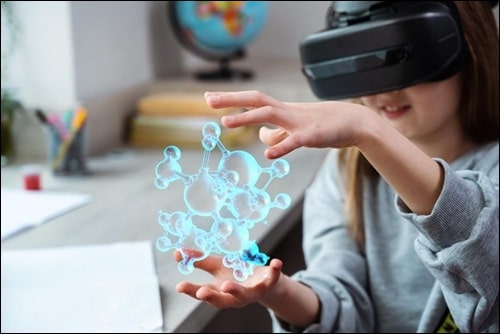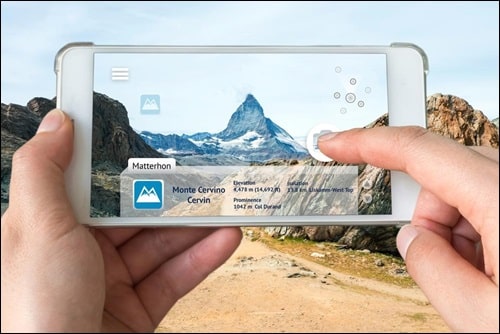Augmented Reality (AR) began as a gaming gimmick. Since those humble beginnings, AR has broken out of video games and entered the real world, with increasingly practical applications. Augmented reality now enhances everything from education and workplace training to shopping, real-time translation services, and street navigation, either through phone apps or, increasingly, wearable devices. But what is augmented reality, and why is the future of AR tied to fiber-optic internet?

1. Understanding Augmented Reality
Augmented reality (AR) overlays digital elements, such as images, text, or 3D models, onto your view of the real world. AR’s combination of reality and digital content differs from virtual reality (VR), which uses headsets and other devices to immerse you in a completely digital environment. AR also differs from mixed reality, an emerging technology that allows for interaction between digital and physical objects.
So, how does augmented reality work? AR uses smartphones, tablets, headsets, and dedicated AR glasses to position digital graphics and text over your environment in real-time. Examples of AR include retail apps that let you “place” furniture in your living room, educational tools that guide students through instructional material, and industrial tools that enhance safety and maintenance.
2. AR in Education
Augmented reality has multiple uses in both online and physical classroom environments. Students can conduct chemistry experiments in a science lab simulation without safety risks, take virtual field trips to international locations, create 3D art, and build virtual models. Course designers use AR to gamify learning by adding challenges and achievements that make learning fun.
Education AR tools boost engagement and retention, but they rely on smooth data delivery. Access to a reliable internet provider ensures that AR apps load quickly and run smoothly, so lessons remain immersive from start to finish.
3. AR in Healthcare
Healthcare benefits from immersive AR tools for healthcare providers and patients alike. Medical students can study 3D anatomy visualizations and explore organs layer by layer from their device screens. In the operating room, surgeons increasingly use AR-assisted navigation to overlay imaging data directly onto a patient’s body, allowing for safer, more precise procedures and identifying details that are not visually apparent. Physical therapists use AR to guide patients through exercises and offer real-time feedback.

AR has revolutionized remote care. Using AR devices allows physicians to see patient bodies in three dimensions. Remote patients can describe the location and severity of symptoms using the same technology.
AR also empowers patient education. Individuals can view their own anatomy, helping them better understand diagnoses and treatment plans from the comfort of their own home. As AR applications rely on cloud-based models and real-time data, patients should consider running an internet speed test before accessing apps to ensure an optimal experience.
4. AR in Retail and Shopping
A quick trip to Amazon reveals how augmented reality works in a retail environment. Amazon and other major online stores offer the option of viewing furniture previews, which use AR device screens to overlay possible purchases onto your surroundings. You can see how the color and style of a particular item work with your existing style and furniture choices.
Virtual try-ons are similar to furniture previews, allowing you to see how clothing looks on you without first trying it on. This is a fast way to evaluate clothing without a changing room, or ordering it online only to discover it doesn’t work with your style preferences and body type. Virtual try-ons also allow you to check out makeup and accessories before you buy, reducing return rates.
In physical retail environments, interactive store experiences provide detailed product information, help you find items in-store, and offer shopping recommendations based on your purchase history. Interactive experiences personalize the store experience, increasing customer engagement and satisfaction.
5. AR in Navigation and Travel
AR navigation takes the functionality of GPS and overlays it on your surroundings. Imagine you’re on foot in a strange city and trying to find a specific destination. Instead of using, say, Google Maps, you can point your phone at the street, and AR directions appear right on the sidewalk. AR can translate street signs, product names, train station maps, and menus into your language in your device’s camera view, reducing misunderstandings and enhancing your trip. Museums, art galleries, and historic tourism sites increasingly employ AR to improve visitor experiences, providing narrated stories, visual aids, and mini-movies as you explore your surroundings. Such innovations require reliable internet connections, of course, and are most common at present in cities and countries with well-established fiber optic internet infrastructure.

6. AR in Home and Lifestyle
Connecting wireless devices to your home network lets you use augmented reality to enhance your daily life. Virtual furniture placement, for instance, has more than just retail applications. You could take pictures of your furniture and use AR to experiment with different furniture arrangements and room layouts. Not sure if that wallpaper or paint color works in your room? AR lets you preview what it would look like on your wall.
AR has a role to play in your next DIY project, too. Use AR-enabled apps to visualize the steps in the project, overlay repair instructions onto the real world, guide you through appliance installation, or position smart lights, thermostats, and speakers where they’ll have the most impact on your daily routine.
Bringing AR into Everyday Life
Augmented reality is a growing part of our everyday world, helping us learn complex concepts, make smarter purchases, and navigate through life. With AR, you can simplify routine tasks and interact with your environment in fresh, engaging ways. Ready to experience the next level of reality? Explore the world through AR today!